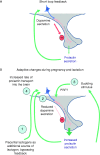60 YEARS OF NEUROENDOCRINOLOGY: The hypothalamo-prolactin axis
- PMID: 26101377
- PMCID: PMC4515538
- DOI: 10.1530/JOE-15-0213
60 YEARS OF NEUROENDOCRINOLOGY: The hypothalamo-prolactin axis
Abstract
The hypothalamic control of prolactin secretion is different from other anterior pituitary hormones, in that it is predominantly inhibitory, by means of dopamine from the tuberoinfundibular dopamine neurons. In addition, prolactin does not have an endocrine target tissue, and therefore lacks the classical feedback pathway to regulate its secretion. Instead, it is regulated by short loop feedback, whereby prolactin itself acts in the brain to stimulate production of dopamine and thereby inhibit its own secretion. Finally, despite its relatively simple name, prolactin has a broad range of functions in the body, in addition to its defining role in promoting lactation. As such, the hypothalamo-prolactin axis has many characteristics that are quite distinct from other hypothalamo-pituitary systems. This review will provide a brief overview of our current understanding of the neuroendocrine control of prolactin secretion, in particular focusing on the plasticity evident in this system, which keeps prolactin secretion at low levels most of the time, but enables extended periods of hyperprolactinemia when necessary for lactation. Key prolactin functions beyond milk production will be discussed, particularly focusing on the role of prolactin in inducing adaptive responses in multiple different systems to facilitate lactation, and the consequences if prolactin action is impaired. A feature of this pleiotropic activity is that functions that may be adaptive in the lactating state might be maladaptive if prolactin levels are elevated inappropriately. Overall, my goal is to give a flavour of both the history and current state of the field of prolactin neuroendocrinology, and identify some exciting new areas of research development.
Keywords: lactation; pregnancy; prolactin; prolactin-releasing factor; tuberoinfundibular dopamine neurons.
© 2015 The authors.
Figures


References
-
- Anderson GM, Beijer P, Bang AS, Fenwick MA, Bunn SJ, Grattan DR. Suppression of prolactin-induced signal transducer and activator of transcription 5b signaling and induction of suppressors of cytokine signaling messenger ribonucleic acid in the hypothalamic arcuate nucleus of the rat during late pregnancy and lactation. Endocrinology. 2006a;147:4996–5005. doi: 10.1210/en.2005-0755. - DOI - PubMed
-
- Anderson ST, Barclay JL, Fanning KJ, Kusters DH, Waters MJ, Curlewis JD. Mechanisms underlying the diminished sensitivity to prolactin negative feedback during lactation: reduced STAT5 signalling and upregulation of cytokine-inducible SH2-domain-containing protein (CIS) expression in tuberoinfundibular dopaminergic neurons. Endocrinology. 2006b;147:1195–1202. doi: 10.1210/en.2005-0905. - DOI - PubMed
-
- Anderson GM, Kieser DC, Steyn FJ, Grattan DR. Hypothalamic prolactin receptor messenger ribonucleic acid levels, prolactin signaling, and hyperprolactinemic inhibition of pulsatile luteinizing hormone secretion are dependent on estradiol. Endocrinology. 2008;149:1562–1570. doi: 10.1210/en.2007-0867. - DOI - PubMed
Publication types
MeSH terms
Substances
LinkOut - more resources
Full Text Sources
Molecular Biology Databases
Research Materials

